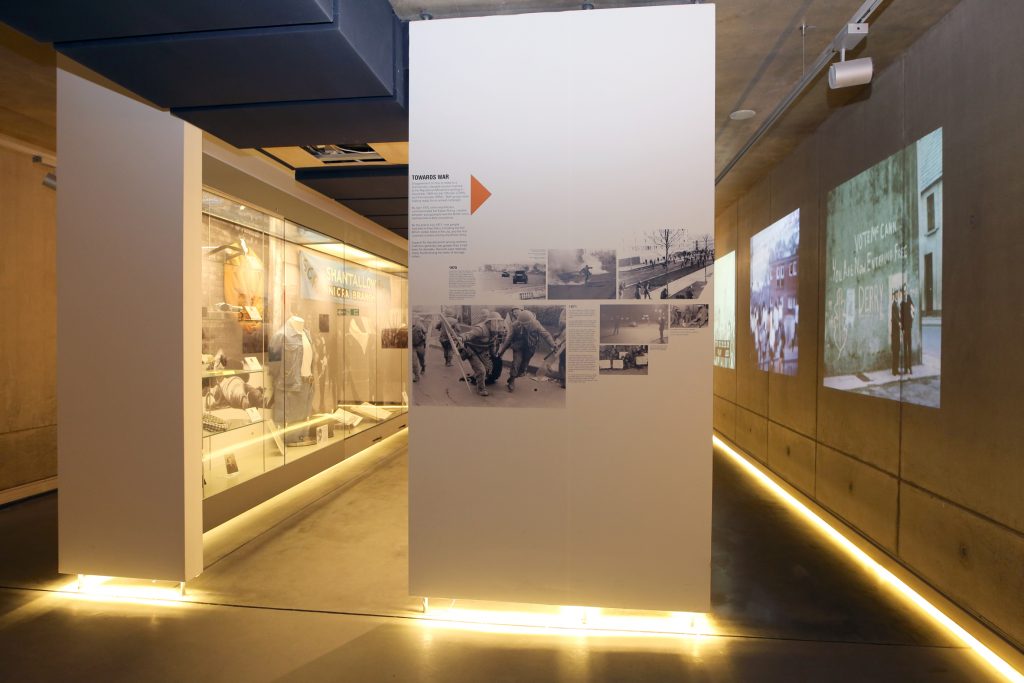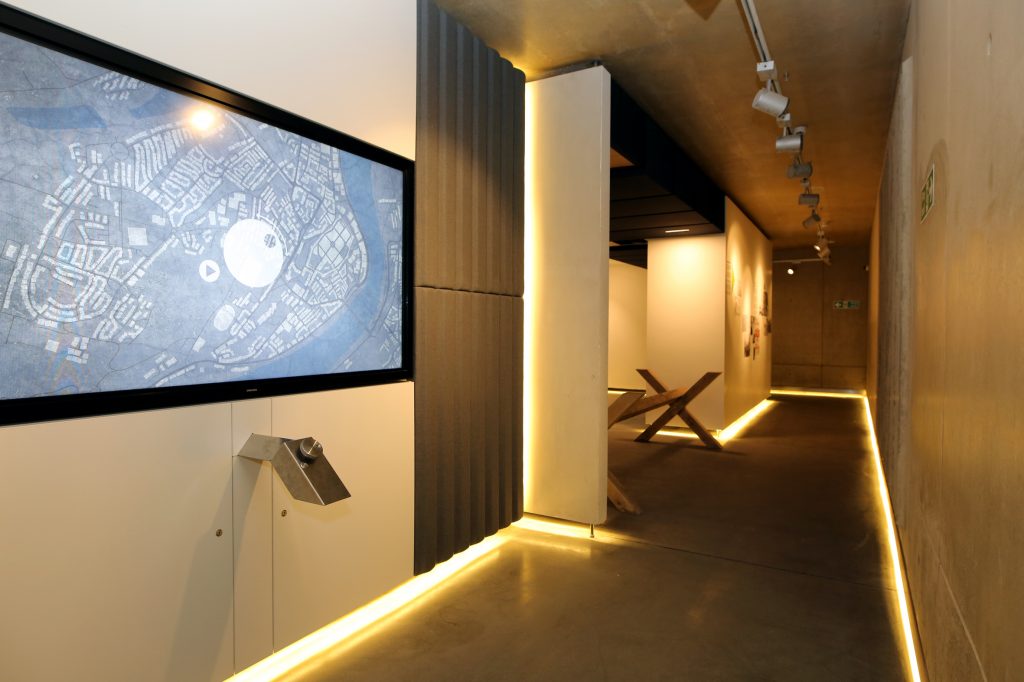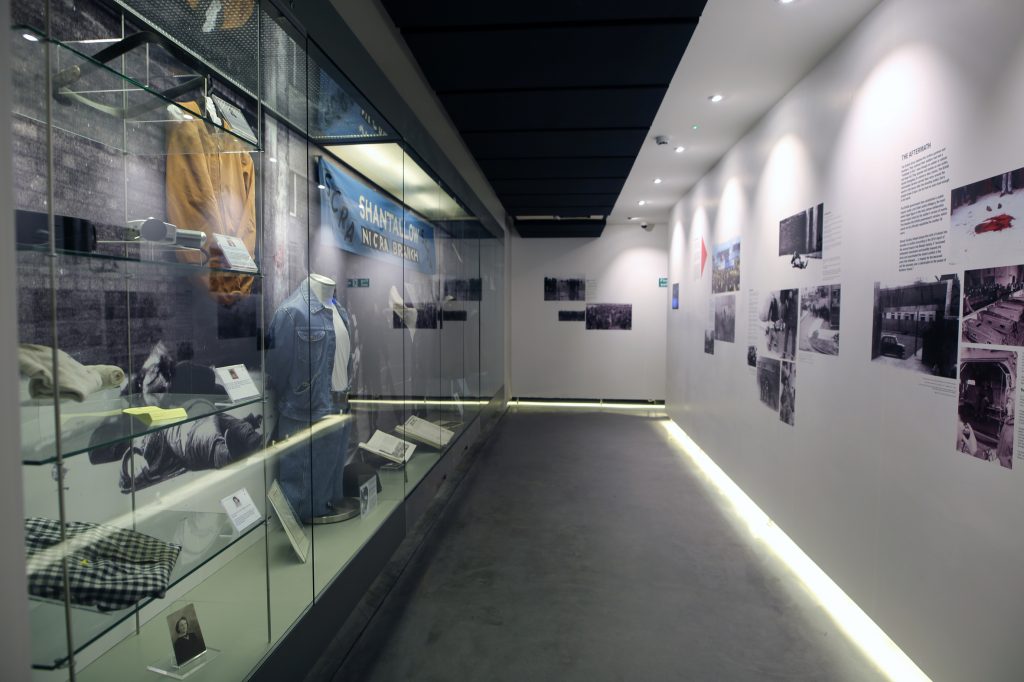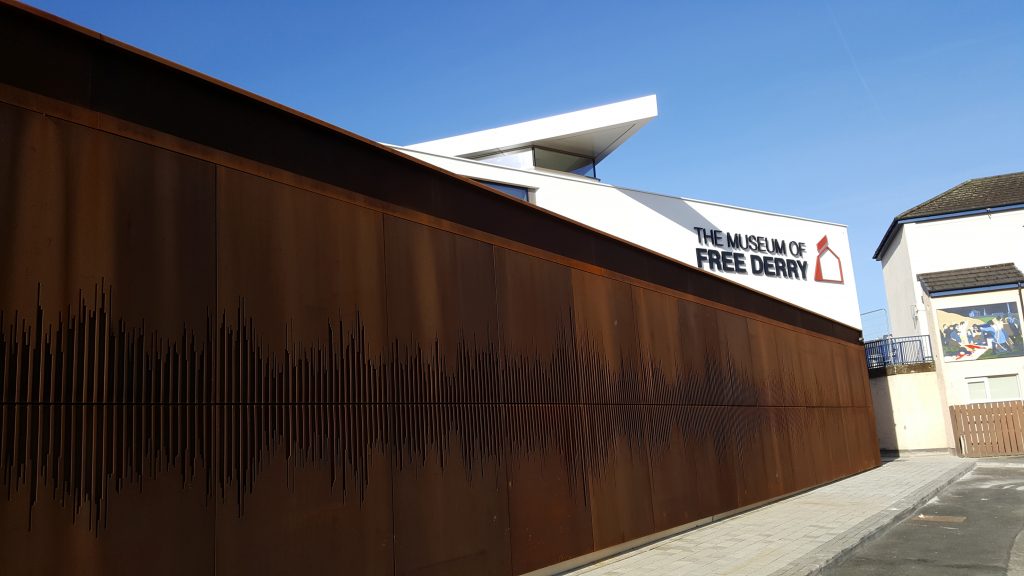Adrian Kerr, Curator of the Museum of Free Derry, the Bloody Sunday Trust project to create a museum in the Bogside to tell the story of the civil rights and Free Derry eras in the late 1960s and early 1970s from the point of view of those who were most involved in and affected by events of that time.
Cover picture: Phase II of Museum of Free Derry was completed in the Bogside in February 2017 | The Museum of Free Derry
“The Museum of Free Derry tells the story of how a largely working-class community rose up against the years of oppression it had endured. The museum and archive has become an integral part of Ireland’s radical and civil rights heritage…
…the museum is a public space where the concept of Free Derry can be explored in both historic and contemporary contexts. Free Derry is about our future together as much as it is about the past. The struggle of Free Derry is part of a wider struggle in Ireland and internationally for freedom and equality for all…
These are among the first words that are read by visitors to the Museum of Free Derry. They set out the aim of the museum – to educate people on what happened here and on the impact of those events on the decades of conflict that followed.
But these words do not seek to define or delineate who we want to educate. They don’t impose any restriction on who we seek to educate based on age or background, political opinion or religious affiliation or, for the purposes of this essay, where they come from.
The Museum of Free Derry was set up by the Bloody Sunday Trust to tell the story of the civil rights and Free Derry eras of the late 1960s and early 1970s. These were years that had massive local, national and international impact, and the events of these years, and the differing perceptions of these events, had and continue to have a major divisive effect on the different communities in the north of Ireland. The issues raised in these years still have to be dealt with, and our museum was set up as a way of resolving them, not just recording them. It was set up to be an active part of the process of resolution and reconciliation, not just a passive window on the past. It was set up as part of a campaign for justice.
The history we tell in the museum is a contested one. When Ireland was partitioned by the British government in 1921, the Unionist Party set about creating their planned “Protestant State for a Protestant People”, arming themselves with a range of repressive legislation and security powers that even the apartheid regime in South Africa expressed envy about, and for the next forty years nationalists in the north of Ireland were forced to endure extremes of political, religious, social and economic discrimination.
At the beginning of the 1960s nationalists in the north of Ireland, taking very direct inspiration from the civil rights movement in the USA, decided that enough was enough. Taking to the streets in peaceful protest they demanded change and they demanded equality. Their peaceful demands were met with a violent reaction, as the Unionist government sensed a threat to their comfortable position of power.

Photographs on walls of the museum show events around the time of the Bloody Sunday, 30th shootings exhibit | The Museum of Free Derry 
View of the interior of the museum and satelite map of the Bloody Sunday shootings | The Museum of Free Derry
On 5 October 1968, at a small civil rights demonstration in Derry, a single television camera captured the violence used by the state against the peaceful protest. The police assault on the march splashed the truth of Unionist misrule onto television screens around the world. In the aftermath of 5 October, the civil rights movement grew, as did opposition to it. Extremes within unionism opposed any changes and called for even more repression. A student civil rights march was attacked by extremists, aided by the security forces, and in the ensuing riots, Free Derry was born.
When, in August 1969, the police again attacked the Bogside, the community there resisted for three days, and in the end, with the police pushed beyond their limits, the British army was sent back onto the streets of the north. They took to the streets of the north as the new armed wing of Unionism, using tactics honed in Kenya, Aden and elsewhere, tactics that had aggravated rather than solved the violent problems there. Clashes with the nationalist population became an everyday occurrence, and support for violent resistance grew.
In August 1971 the British and Unionist governments decided on the reintroduction of internment without trial, a tactic they used almost exclusively against the nationalist population. And it was at an anti-internment march in January 1972 that the British government showed just how far they were prepared to go in the face of peaceful and dignified protest.
As 15,000 people made their way through the streets of Creggan and the Bogside in Free Derry members of the British Army’s elite Parachute Regiment were waiting. When the marchers reached the barricades, most turned to peacefully make their way towards Free Derry Corner for a rally. The paratroopers followed them, firing indiscriminately into the crowd.
In the next 10 minutes or so the British army killed 13 unarmed men and boys and wounded 18 others, including two women, one of them a mother of 14 young children. One of the wounded died from his wounds just a few months later.
The British labelled the unarmed dead gunmen and bombers. They concocted a judicial cover-up for their actions. It took them 38 years to admit some of the truth, that Bloody Sunday was “unjustified and unjustifiable” and that all the victims were innocent.
In the early hours of 31 July, the British Army launched Operation Motorman, using 21,000 troops to smash Free Derry and other no-go areas.
By daylight Free Derry was under armed occupation. For the next 22 years it was one of the most heavily militarised areas in western Europe.
The Museum of Free Derry has been developed through three distinct phases. It first opened in 2006 with a basic display on Bloody Sunday, then reopened in 2007 as a museum covering the full period that we felt we needed to, from the years of government oppression, through the civil rights struggle and into the early years of the conflict here. The second phase proved successful enough to attract the support and funding necessary to reach the third phase that we have today – a multi-award winning museum in the heart of the Bogside.
The new Museum of Free Derry is now in a purpose built two-storey building, with a dedicated core space designed to host the permanent display. This multi-media exhibition covers an introduction to the history of the Bogside, then focuses on the key years from the birth of the civil rights movement, through the early years of the conflict here to Bloody Sunday and Operation Motorman, the British attempts to violently crush the civil rights movement and Free Derry. We also have a more flexible space on the first floor which we use for temporary exhibitions, conferences, films, debates etc, which has enabled us to greatly expand on the work of the museum and create more events aimed at our local audience, events with a more international flavour and also events looking at wider civil and human rights issues. The new building also has an archive and research area so we can make our collection more widely accessible, and much improved reception and visitor service spaces. The building is enveloped in a stunning public artwork, which shows a soundscape of the moment on the Bloody Sunday march when the crowd was singing ‘We shall Overcome.”

The new museum hosts almost 40,000 visitors every year, all here to be educated about our story. We take a very clear stance on how we tell this story – it is our story, the story of our people and our community, and it is told unashamedly from that perspective.
The museum is on the site where many of the key events of the story occurred, including Bloody Sunday. The story is told to visitors by people who were directly involved in and affected by this history. The artefacts on display in the museum reinforce this, with many personal artefacts chosen to reinforce the human element of the story, giving identities back to people who had become mere statistics in many histories of the conflict.
All these elements together – the story, the artefacts, the staff and the site – make a visit to our museum a very emotional and moving experience. Visitors don’t just get information on what happened here; they get a true feel for what happened, why it happened, and how it affected our community. They get an understanding of how these events shaped the years of violent conflict that followed. They get a feeling for the full impact of these events.
And in our experience, with over a quarter of a million visitors to date, that is what they want.
So how do we reconcile the fact that what we set up, with clear educational and conflict resolution aims, has now become a must-see destination for visitors to this city? With the fact that the majority of our visitors would be classed as tourists? That we have an educational aim, but rely on a tourist income, which includes grant funding heavily reliant on the service we provide for visitors to the city?
The simple answer is that we don’t. We don’t feel the need to. We are providing what we want to provide, and that happens to be exactly what visitors come here to see.
Anyone who visits this museum is here to learn about what happened here, they are all educational visitors. They want to learn the story first-hand, in the place where it happened and from the people who were involved in it. They don’t want a compromised version, tailored or softened for a perceived audience. They don’t want something that they could read on the internet or in a book. The fact that this is what we provide is one of our greatest strengths.
